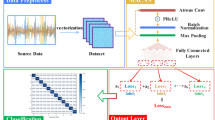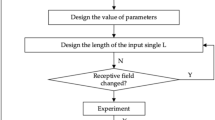Abstract
Recently, deep learning methods such as convolutional neural networks (CNN) have been widely used in fault diagnosis of rotating machinery. However, most methods are not designed to consider the influence of the working conditions and limited to classifying several fault types. In this paper, we propose two CNN-based multitask models, i.e., sigmoid multitask fault diagnosis model and multisoftmax multitask classification model, which can classify the fault types and the working conditions of the signal simultaneously. All samples are jointly learned at the shared network layers, and different types of learning tasks are completed at different subnetwork layers. Results show that the proposed sigmoid multitask fault diagnosis model achieves the overall classification accuracy of 96.8% when testing the CWRU bearing dataset. The proposed multisoftmax multitask classification model is used to classify different working conditions and fault types of planetary gearbox. With frequency signals as inputs, the accuracy rate is able to reach 96.2%, and the classification accuracy of gear and speed conditions reaches more than 99%. Additionally, the gradient-weighted class activation mapping (Grad-CAM) method is used to visualize the weight vectors of different convolutional layers and locate the signal segment of interest to the model.


















Similar content being viewed by others
References
Yang L, Wang J, Zhang G (2016) Aviation PHM system research framework based on PHM big data center. In: Proceedings of the 2016 IEEE international conference on prognostics and health management (ICPHM). IEEE
Hoang DT, Kang HJ (2018) A survey on deep learning based bearing fault diagnosis. Neurocomputing
Janssens O, Slavkovikj V, Vervisch B et al (2016) Convolutional neural network based fault detection for rotating machinery. J Sound Vib 377:331–345
Ding X, He Q (2017) Energy-fluctuated multiscale feature learning with deep convnet for intelligent spindle bearing fault diagnosis. IEEE Trans Instrum Meas 66(8):1926–1935
Ince T, Kiranyaz S, Eren L et al (2016) Real-time motor fault detection by 1-D convolutional neural networks. IEEE Trans Ind Electron 63(11):7067–7075
Jing L, Zhao M, Li P, et al (2017) A convolutional neural network based feature learning and fault diagnosis method for the condition monitoring of gearbox. Meas J Int Meas Confed
Jia F, Lei Y, Lin J et al (2016) Deep neural networks: a promising tool for fault characteristic mining and intelligent diagnosis of rotating machinery with massive data. Mech Syst Signal Process 72–73:303–315
Shao H, Jiang H, Zhang H et al (2017) Electric locomotive bearing fault diagnosis using novel convolutional deep belief network. IEEE Trans Ind Electron 65(3):1–1
Guo X, Chen L, Shen C (2016) Hierarchical adaptive deep convolution neural network and its application to bearing fault diagnosis. Measurement 93:490–502
Barszcz T, Randall RB (2009) Application of spectral kurtosis for detection of a tooth crack in the planetary gear of a wind turbine. Mech Syst Signal Process 23(4):1352–1365
Prieto MD, Cirrincione G, Espinosa AG et al (2013) Bearing fault detection by a novel condition-monitoring scheme based on statistical-time features and neural networks. IEEE Trans Ind Electron 60(8):3398–3407
Cerrada M, Zurita G, Cabrera D et al (2015) Fault diagnosis in spur gears based on genetic algorithm and random forest. Mech Syst Signal Process 70–71:87–103
Yan K, Zhang D (2016) Calibration transfer and drift compensation of e-noses via coupled task learning. Sens Actuators B Chem 225:288–297
Wen L, Gao L, Li X (2017) A new deep transfer learning based on sparse auto-encoder for fault diagnosis. IEEE Trans Syst Man Cybern Syst 49(1):1–9
Yang P, Zhao P, Gao X (2017) Robust online multi-task learning with correlative and personalized structures. IEEE Trans Knowl Data Eng 29(11):1–1
Sun Y, Wang X, Tang X (2014) Deep learning face representation by joint identification-verification. Adv Neural Inf Process Syst
Ren S, He K, Girshick R et al (2015) Faster R-CNN: towards real-time object detection with region proposal networks. IEEE Trans Pattern Anal Mach Intell 39(6):1137–1149
Zhang N, Donahue J, Girshick R et al (2014) Part-based R-CNNs for fine-grained category detection. European conference on computer vision. Springer, Cham, pp 834–849
Li X, Zhang W, Ding Q (2019) Understanding and improving deep learning-based rolling bearing fault diagnosis with attention mechanism. Signal Process 161:136–154
Selvaraju RR, Cogswell M, Das A, et al (2016) Grad-CAM: visual explanations from deep networks via gradient-based localization
Jonas S, Rossetti AO, Oddo M, Jenni S, Favaro P, Zubler F (2019) EEG-based outcome prediction after cardiac arrest with convolutional neural networks: performance and visualization of discriminative features. Hum Brain Mapp 40(16):4606–4617
Wu C, Jiang P, Feng F et al (2019) Intelligent fault diagnosis of rotating machinery based on one-dimensional convolutional neural network. Comput Ind 108(2019):53–61
Mahendran A, Vedaldi A (2015) Visualizing deep convolutional neural networks using natural pre-images. Int J Comput Vis 120(3):233–255
Author information
Authors and Affiliations
Corresponding author
Ethics declarations
Conflict of interest
We declare that we have no financial and personal relationships with other people or organizations that can inappropriately influence our work, and there is no professional or other personal interest of any nature or kind in any product, service and/or company that could be construed as influencing the position presented in, or the review of, the manuscript entitled “Research on multitask fault diagnosis and weight visualization of rotating machinery based on convolutional neural network.”
Additional information
Technical Editor: Wallace Moreira Bessa.
Publisher's Note
Springer Nature remains neutral with regard to jurisdictional claims in published maps and institutional affiliations.
Rights and permissions
About this article
Cite this article
Feng, F., Wu, C., Zhu, J. et al. Research on multitask fault diagnosis and weight visualization of rotating machinery based on convolutional neural network. J Braz. Soc. Mech. Sci. Eng. 42, 603 (2020). https://doi.org/10.1007/s40430-020-02688-6
Received:
Accepted:
Published:
DOI: https://doi.org/10.1007/s40430-020-02688-6




